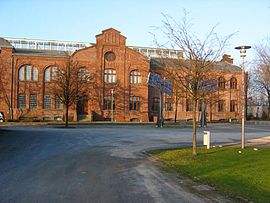Arenberg colliery continuation
| Arenberg colliery continuation | |||
|---|---|---|---|
| General information about the mine | |||
|
Arenberg colliery continuation |
|||
| Information about the mining company | |||
| Start of operation | 1863 | ||
| End of operation | 1930 | ||
| Successor use | Allocation to Prosper III mine | ||
| Funded raw materials | |||
| Degradation of | Hard coal | ||
| Geographical location | |||
| Coordinates | 51 ° 31 '59 " N , 6 ° 57' 51" E | ||
|
|||
| Location | Batenbrock | ||
| local community | Bottrop | ||
| Independent city ( NUTS3 ) | Bottrop | ||
| country | State of North Rhine-Westphalia | ||
| Country | Germany | ||
| District | Ruhr area | ||

The colliery Arenberg sequel was a coal - mine in Bottrop .
history
In January 1856, members of the well-known entrepreneurial families Waldthausen , Hammacher , Haniel , Huyssen , Morian and Grillo founded the Arenbergsche Bergbau- und Hüttengesellschaft , which, following a change in the statutes, has been operating under the name Arenbergsche Aktiengesellschaft für Bergbau- und Hüttenbetrieb since May 1856 . The initially acquired assumptions Gottfried , Constantinople , Maximilian and Prosper I - VI were all in the Bottrop area. The owner of the Bergregal was the Duke Prosper von Arenberg . This explains the name of the company.
- 1856 Start of sinking for the Prosper I shaft (1863 extraction),
- 1871 Start of sinking for the Prosper II shaft (1875 extraction),
- 1893 sinking of the weather shafts 3 and 4,
- 1909/1910 Participation in the establishment of the Arenberg Continuation Union.
From 1910 to 1930 the Arenberg colliery continued in operation. After the first sinking work in 1910, coal mining began in 1912 on the modern Arenberg-Continuation double shaft system. The construction of the company building was accordingly quick.
The original symmetry of the entire complex in its compact design corresponded to the desire for representation of the early days . The love for playful detail can still be seen today. Examples of this are the window shapes and banisters. Its design is characterized by the ornamentation of Art Nouveau with its curved lines. After the final closure in 1930, the site lay fallow for 60 years. A start-up center was created as part of the International Building Exhibition (IBA).
In 1919 the Arenberg Continuation Union was transferred to Rheinische Stahlwerke AG . The merger between Arenberg AG for mining and smelting works and Rheinische Stahlwerke AG took place in 1922. From then on there was an Arenberg department within Rheinische Stahlwerke AG .
Shutdown
The global economic crisis prompted Rheinische Stahlwerke AG to consolidate hard coal production. Therefore, the conveyor system “Arenberg Continuation” 1/2 and the coking plant were shut down in 1930. The shafts were assigned as the outdoor facility of the Prosper III mine .
Current condition
After the Arenberg shafts have been dropped, no more conveyor systems can be seen. Some monumental outbuildings in the style of the time around 1910 have been preserved. There are commercial settlements on the colliery site. The coal liquefaction plant was put into operation again experimentally in 1981 by Ruhrkohle AG as the "coal oil plant Bottrop". It was in operation until 1992. Today this is the seat of the state-owned society for innovative employment promotion (GIB NRW).
Others
In 1958 a bulk carrier operated by the shipping company Frigga for Rheinische Stahlwerke AG was named MS Arenberg .
literature
- Wilhelm and Gertrude Hermann: The old collieries on the Ruhr (series: The Blue Books ). 6th edition. Verlag Langewiesche Nachhaben, Königstein im Taunus 2008, ISBN 978-3-7845-6994-9 , p. 162.


